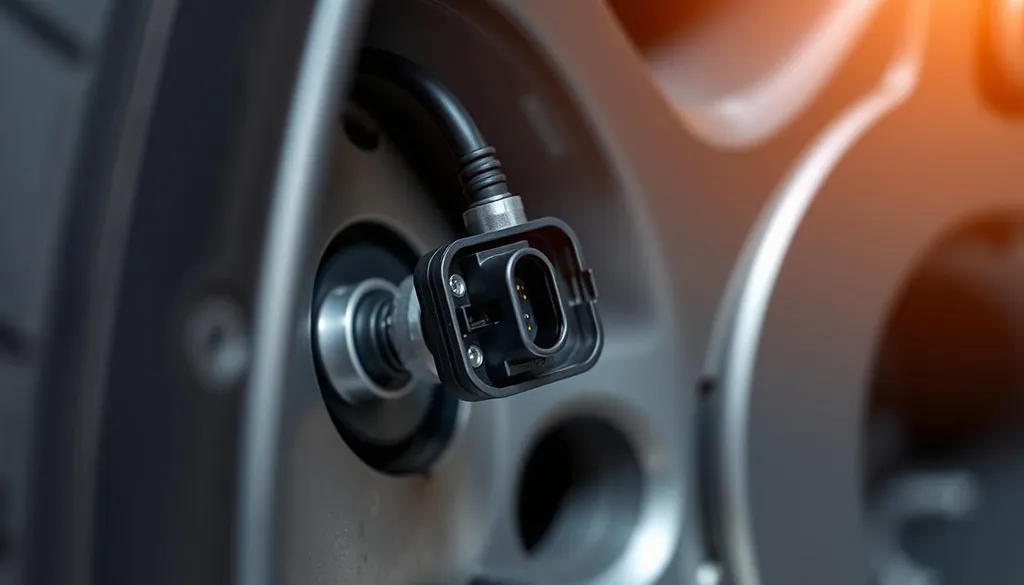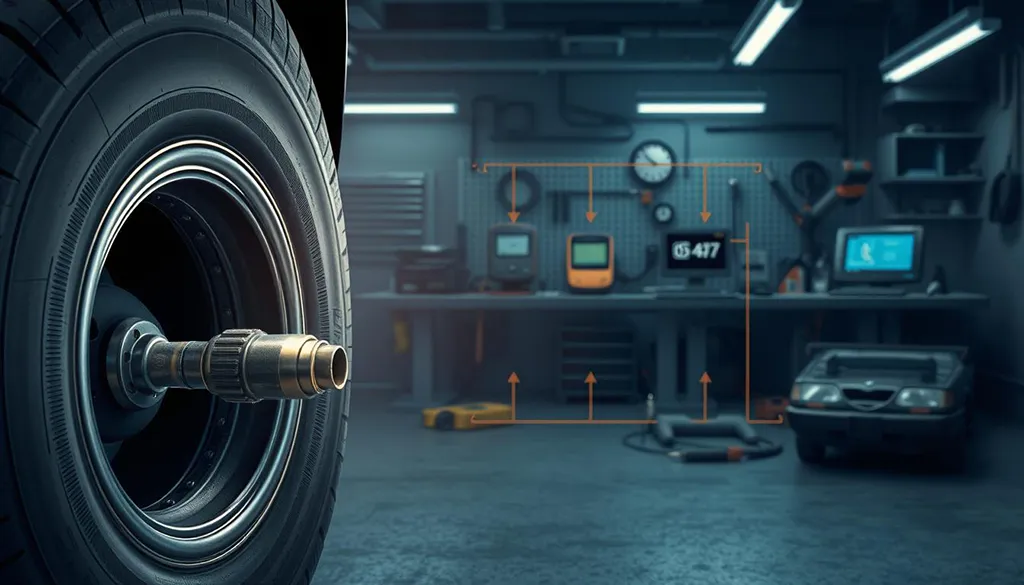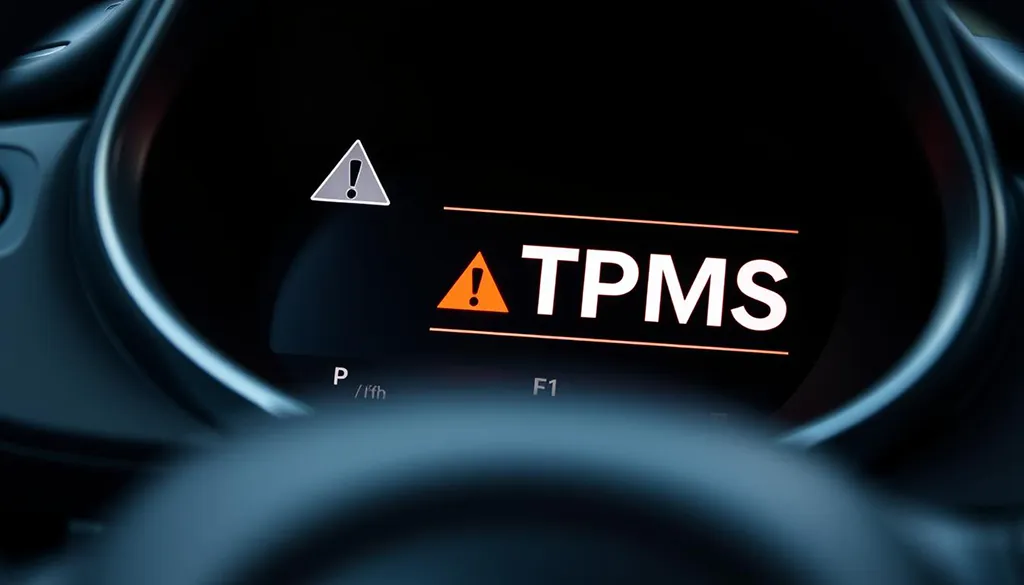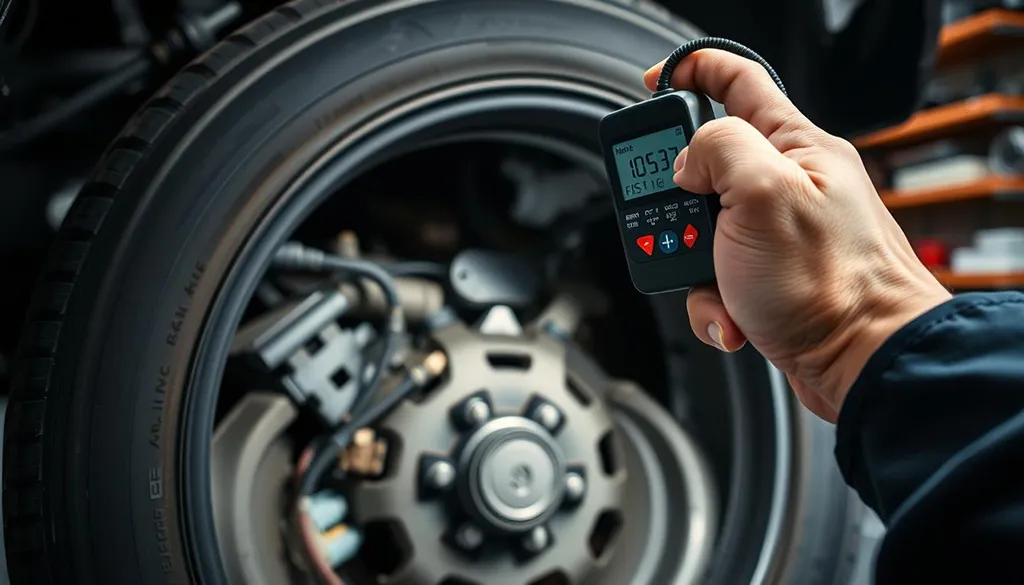The Tire Pressure Monitoring System (TPMS) is key in modern cars. It alerts us when tire pressure is low. Knowing how to fix tire pressure sensor faults is vital for safety and performance.
Under-inflated tires affect handling and increase wear and fuel use. A solid yellow TPMS light means one or more tires need attention. A flashing light shows a system malfunction.
This article will help me diagnose and fix tire pressure sensor faults. I’ll learn about common causes and symptoms. I’ll also discover how to reset the sensor and prevent future problems.
Key Takeaways
- Tire Pressure Monitoring System enhances vehicle safety by detecting low tire pressure.
- Common causes of TPMS faults include battery issues, damage, and sensor age.
- Regular tire pressure checks are vital for optimal performance and safety.
- Knowing how to perform a tire pressure sensor fault reset can save time and money.
- Always consult a professional when faced with complex tire pressure sensor issues.
Understanding Tire Pressure Sensors
Tire pressure sensors, or TPMS, are key to car safety. All cars sold in the U.S. after 2008 must have these systems. They help keep tires at the right pressure, warning drivers of any problems.
TPMS checks tire pressure and alerts drivers with dashboard lights. A steady light means tires are too low. There are two main types: direct and indirect systems. Direct systems show each tire’s pressure, while indirect systems use ABS to check speed.

Understanding Tire Pressure Sensors
TPMS sensor batteries last 5 to 10 years. Regular checks and replacements are needed. This is because temperature changes can lower tire pressure, affecting safety and fuel use.
Knowing how TPMS works helps drivers keep their cars safe. It’s important for safe driving and following NHTSA rules.
Common Causes of Tire Pressure Sensor Fault
It’s important to know why tire pressure sensors might go wrong. Many things can cause these problems, so checking them often is key. These issues can shorten the life of the sensors and lead to wrong readings or not working at all. Here are some common reasons for these problems.
Low Battery Voltage
Low battery voltage can cause tire pressure sensor faults. If the battery voltage is too low, the sensor might not work right. This can lead to false warnings on the dashboard. It’s a good idea to check the battery’s health, which is more important in cars like Ford.
Damage from Road Debris
Driving over loose gravel or sharp objects can damage tire pressure sensors. Potholes can also harm them. It’s important to watch out for these hazards when driving.
Exposure to Extreme Temperatures
Extreme temperatures can hurt tire pressure sensors. Cold weather can weaken the battery, while hot weather can make parts expand and fail. I need to think about these issues, mainly when I’m on long trips.

Common Causes of Tire Pressure Sensor Fault
Corrosion of Sensors
Moisture and road salt can cause corrosion on sensors. This can damage the electrical connections and lead to faults. Regular maintenance can help prevent this.
Sensor Age and Wear
As sensors get older, they can become less accurate. Most last about 5 to 10 years. Over time, they can wear out, so they might need to be replaced.
Faulty Wiring Issues
Bad wiring is a big problem for tire pressure monitoring systems. Damaged or short-circuited wires can disrupt communication between sensors and the car’s system. This can cause false alerts. I should check the wiring during routine checks.
| Common Cause | Impact | Recommendations |
| Low Battery Voltage | Faulty sensor alerts | Regular battery checks |
| Damage from Road Debris | Sensor malfunction | Avoid rough terrains |
| Exposure to Extreme Temperatures | Decreased performance | Monitor conditions |
| Corrosion of Sensors | Electrical issues | Routine maintenance |
| Sensor Age and Wear | Inaccurate readings | Replace after 5-10 years |
| Faulty Wiring Issues | False warnings | Regular wiring inspections |
What Does Tire Pressure Sensor Fault Mean?
A tire pressure sensor fault means there might be a problem with the Tire Pressure Monitoring System (TPMS). Seeing the TPMS warning light on my dashboard tells me something’s off. It could be a real tire issue or a system failure.
It’s important to know the difference between a real tire problem and a system fault. If the sensor is faulty, it might show wrong tire pressure readings. This can be dangerous, affecting how well my car handles and how much fuel it uses.

What Does Tire Pressure Sensor Fault Mean?
Ignoring these warnings can lead to big problems. For example, it could make my car use up to 25% more fuel. Also, faulty TPMS can cause tire blowouts, leading to thousands of accidents every year in the U.S.
So, it’s key to act fast when I see the TPMS light. Fixing the issue keeps my car safe and running smoothly. This way, I can keep my vehicle in top shape.
Symptoms of a Tire Pressure Sensor Fault
Knowing the signs of a tire pressure sensor fault is key for keeping your vehicle safe and running well. Spotting these signs early can stop bigger problems and keep your tires in top shape.
Dashboard Warning Light
A common sign is the dashboard warning light coming on. This light means one or more tires are underinflated by 25% or more. Not paying attention to this warning can cause serious damage or make driving unsafe.
Inaccurate Tire Pressure Readings
Another sign is when the TPMS shows tire pressure that doesn’t seem right. If the readings are always off, it might mean the sensors are not working right. Wrong readings can make the TPMS less effective, which is a safety risk.

Symptoms of a Tire Pressure Sensor Fault
Inability to Reset the TPMS Warning Light
If you can’t reset the TPMS warning light after checking the tire pressure, it’s a big clue. This usually means there’s a problem with the system that needs fixing before you drive.
Unresponsive TPMS System
An unresponsive TPMS system is a big worry. It means the system can’t check tire pressure, which could be due to wiring, sensor, or software issues. Seeing these signs means you need to act fast to avoid safety risks.
Diagnosing a Tire Pressure Sensor Fault
Figuring out why a tire pressure sensor isn’t working right needs a careful plan. I use special tools to check the tire pressure monitoring system (TPMS). The right tools make it easier to spot problems and avoid mistakes.
Tools for Diagnosis
Here are the tools I use to find out what’s wrong with a tire pressure sensor:
- Tire Pressure Gauge: An accurate gauge is key. Digital gauges are usually the most precise.
- TPMS Diagnostic Tool: This tool turns on sensors and checks their signals. It helps find communication problems.
- Voltage Meter: This tool checks voltage drops in wiring. It shows if resistance is causing signal issues.
- Scan Tool: This tool reads fault codes. It gives important info about the TPMS module’s performance.
TPMS sensor batteries usually last 7 to 10 years, depending on how much you drive. Using these tools regularly can stop problems before they start.
Interpreting Warning Signs
It’s important to know how the TPMS system works. If I get a “no sensor signal” code, it might mean a wiring problem or a damaged antenna, not a bad sensor. My goal is to find out what’s really wrong, whether it’s a sensor problem or low air pressure.
- Dashboard warning lights turn on without reason.
- Tire pressure readings are off, even after checking them.
- Can’t reset the TPMS warning light after fixing the problem.

Interpreting Warning Signs
Electromagnetic interference (EMI) can mess with signals, causing false problems. Using good tools to check tire pressure keeps everyone safe and helps sensors last longer.
Troubleshooting Tire Pressure Sensor Issues
Tire pressure sensors are key to keeping vehicles safe by checking tire pressure. If they fail, it can cause wrong readings and safety risks. It’s vital to fix these problems quickly with the right troubleshooting steps. I’ve found some DIY fixes and when to call a pro.
DIY Solutions for Temporary Fixes
One common fix is to reset the TPMS. This is done by following steps in your car’s manual. Also, make sure tire pressures are at the right levels. I check mine often, like when the weather changes, because cold weather lowers tire pressure.
If resetting doesn’t work, check the sensor’s battery. Low battery can cause problems. TPMS sensors last about 5–7 years, so if yours are getting old, it might be time for new ones.
When to Seek Professional Help
Some problems need a pro’s help. If the dashboard light keeps coming on after trying DIY fixes, it might mean a bigger issue. This could be corrosion, bad wiring, or damaged sensors. These problems need a pro to fix with the right tools.
When you need to replace or program sensors, get a pro’s help. The cost of parts can vary, and proper installation is key to keeping the system working right.
How to Fix a Tire Pressure Sensor Fault
Fixing a tire pressure sensor fault is key for your car’s safety and performance. Often, checking the battery voltage can solve the problem quickly. Let’s look at how to fix these faults, focusing on Ford models.
Checking Battery Voltage
First, I check the battery voltage of the tire pressure sensors. Low voltage is a common reason for faults in Ford cars. I use a multimeter to check if the voltage is right. If it’s too low, I replace the battery to fix the issue.
Reprogramming or Resetting the Sensor
Reprogramming or resetting the sensor can also solve the problem. I follow the car’s manual for this. Most Fords need me to turn on the car without starting it, then press a reset button. After resetting, I check the dashboard for any warnings. If it works, the TPMS light should go off.
When to Replace Your Sensor
It’s important to know when to replace your tire pressure sensors. If they’re over five to ten years old or give inconsistent readings, it’s time to replace them. This keeps the tire pressure system working right, reducing the risk of blowouts and saving fuel. Replacing a sensor costs between $200 to $440, depending on the parts and labor.
Tire Pressure Sensor Fault Reset
Resetting the tire pressure monitoring system (TPMS) is key when you have a tire pressure sensor fault. This makes sure the system shows the right tire pressure. This is important for safe driving.
First, I check that all tires are at the right pressure. If a tire is too low, it can cause problems with the reset.
Then, I find the reset button. It’s usually under the steering wheel or in the glove box. Press it for a few seconds until the TPMS light blinks three times.
After that, I drive for at least 15 minutes. This lets the system adjust and work right again. Keeping up with this reset helps avoid problems from old or corroded sensors.
If you keep getting alerts after resetting, it’s best to get help from a pro. Knowing how to reset the tire pressure sensor can make your car safer and run better.
| Step | Action |
| 1 | Ensure all tires are inflated to the correct pressure. |
| 2 | Locate the TPMS reset button. |
| 3 | Press and hold the reset button for a few seconds. |
| 4 | Drive the vehicle for at least 15 minutes to complete the reset. |
Preventing Future Tire Pressure Sensor Faults
Keeping tire pressure sensors in top shape is key for vehicle safety and reliability. Regular checks on tire pressure can greatly lower the chance of system faults. By sticking to a routine, I ensure sensors work well, avoiding expensive fixes later.
Regular Maintenance Practices
Regular care is vital to avoid tire pressure sensor faults. Here are some good practices to follow:
- Check tire pressure monthly, making sure it matches the manufacturer’s specs.
- Swap out TPMS batteries every 5-7 years to dodge sensor problems.
- Look for corrosion and damage on sensors often.
- Make sure wiring connections are tight and not worn out.
Understanding the Importance of Proper Tire Pressure
Right tire pressure stops sensor troubles and boosts car performance. I’ve found that:
- Low tire pressure hurts fuel efficiency, raising costs.
- Under-inflated tires lead to uneven wear, needing more replacements.
- Top-notch TPMS systems boost safety, meeting rules from September 2007.
Driving with a Faulty TPMS: Risks and Considerations
Driving with a faulty TPMS is risky. It can give wrong tire pressure readings, making driving unsafe. I’ve seen how it can turn on the dashboard warning light, showing tire inflation problems.
Ignoring this warning can lead to tires being too low or too high. Under-inflated tires wear out faster, making it harder to control the car, even on highways. Over-inflated tires can also wear down and even blow out.
Driving on a flat tire is another danger. It can harm the wheel, brakes, and other car parts. Fixing these problems can be expensive if not done quickly. Replacing a faulty tire pressure sensor costs between $50 and $100.
Driving with a faulty TPMS is risky. It can cause tire blowouts, which are more likely when tire pressures are wrong. Under-inflated tires lose 20% of their grip on wet roads, increasing accident chances. This shows why keeping tire pressure right is key for safety and car performance.
In some places, driving without a working TPMS is illegal, with fines up to $200. Using an inflator gauge, which is cheap, can help keep tire pressure safe. I recommend checking tire pressure often and fixing TPMS problems fast.
Legal and Compliance Aspects of TPMS
It’s important for every car owner to know about the legal side of tire pressure sensors. The National Highway Traffic Safety Administration (NHTSA) has strict rules for TPMS to make roads safer. Cars, trucks, and buses under 10,000 pounds must have working TPMS systems.
The rules started on November 1, 2003, and ended on October 31, 2006. During this time, car makers had to meet certain standards. They had to alert drivers when tire pressure was 25 percent or more below what the maker suggests. Or, they could warn at 30 percent below the suggested levels.
The NHTSA has a clear plan for following these rules. They want all cars to warn drivers of low tire pressure within 20 minutes by the fourth year. This rule is not just for safety but also for the protection of everyone on the road.
The TREAD Act of 2000 started these rules. It said a warning system for low tire pressure had to be in place within two years. Car makers also had to tell owners how to understand the low tire warning in the manual.
Ignoring these rules can cause big problems for both car makers and owners. Knowing the legal side of tire pressure sensors helps keep everyone safe. It also makes sure car owners take care of their vehicles properly.
Repairing TPMS Issues
Dealing with TPMS problems? Knowing your options is key. A tpms bypass emulator can act as a quick fix. It simulates sensor work and is a cost-effective choice without risking safety.
Using TPMS Bypass Emulator
A tpms bypass emulator is a budget-friendly fix, starting at €69.99. It lets your car’s system work as usual. This is great for fixing faults from damaged sensors or dead batteries. Plus, it’s easy to install if you know a bit about cars.
Consulting a Professional Mechanic
Even with a bypass emulator, getting a mechanic’s opinion is smart. They can spot deeper issues like wiring or software problems. A pro will check everything to make sure your car is safe to drive.
Conclusion
Understanding tire pressure sensor faults is key for keeping vehicles safe and running well. Regular checks and quick action when problems show up can lower accident risks. The Tire Pressure Monitoring System (TPMS) alerts me to tire pressure changes, keeping me and others safe.
Common reasons for tire pressure sensor faults include low battery, extreme temperatures, and damage from debris. Keeping an eye on these issues helps avoid system failures and costly repairs. Ignoring warning lights can be dangerous and waste fuel, so it’s important to act fast.
Fixing and keeping tire pressure sensors in check is a driver’s duty. Regular checks and maintenance save money and improve driving. By staying on top of it, my TPMS works right, letting me drive safely and worry-free.
FAQ
What does a tire pressure sensor fault mean?
A tire pressure sensor fault means there might be a problem with your car’s Tire Pressure Monitoring System (TPMS). This could be due to incorrect tire pressure readings or sensor issues. It’s important to check it right away.
How can I diagnose a tire pressure sensor fault?
To find out what’s wrong, use tools like tire pressure gauges and scan tools. First, check the tire pressure. If it’s low, you might just need to add air. But if the readings are off, it could be a TPMS problem.
What are the common symptoms of a tire pressure sensor fault?
Signs include a dashboard warning light, wrong tire pressure readings, and trouble resetting the TPMS light. If your TPMS system doesn’t respond, it’s time to get it checked.
How do I troubleshoot tire pressure sensor issues?
Start with simple steps like checking and resetting the tire pressure. If that doesn’t work, you might need professional help. Finding the root cause is key to fixing the problem.







